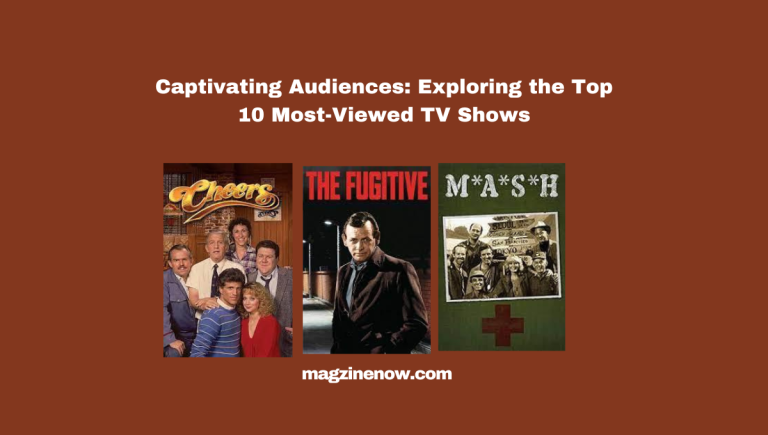Introduction
In American homes for more than five decades, television delivers entertainment, distraction, and cultural reference points. Some TV shows eventually have turned into international megahits garnering unprecedented ratings. We focus on the top 10 best programs or television shows of all time. They also point out the reasons for their immense popularity for many years now.
M*A*S*H (1972–1983)
One of the most-watched American TV programs in history is “M*A*S*H”. Its final episode “Goodbye Farewell, and Amen” had an astonishing audience of 105 million within the U.S. only. This is because the show happened during the Korean War and combined elements of comedy and drama as seen in the challenges posed for those at the 407^{th} MASH. It succeeded because of fine writing, and lovable characters; it dealt with serious matters lightly.
Cheers (1982–1993)
Cheers was an American comedy series, which ran for eleven seasons in its heyday of popular culture and was the greatest hit. Its ensemble cast, astute writing, and the chemistry between characters such as Sam Malone played by Ted Danson, and Diane Chambers played by Shelley Long, are Over 84 million people watched the final installment “One for the Road”. Cheers not only entertained but also became an expression of friendship whose people know you by name.
The Fugitive (1963–1967)
Following Dr. Richard Kimble (David Janssen), who was wrongfully convicted of his wife’s murder, as he attempted to clear his name while being pursued by the relentless Lt. Gerard (Barry Morse), “The Fugitive” captivated audiences during its four-season run, reaching its zenith with the series finale, “The Judgment: The second portion, referred to as ‘Part 2’, received over 78million audiences. As a suspenseful narrative, it was made extremely popular by its last, resolution-giving episode.
Friends (1994–2004)
In this way, “Friends” remains one of the funniest and most beloved sitcoms, which continues to make viewers laugh despite being of another generation with their humor and relatable characters. This series became hugely popular with “The Last One”, the final episode attracting 52 million audiences.
Seinfeld (1989–1998)
One time people refer to it as a show that portrays nothing but still manages to get the people hooked on it. More than 76 million people watched “The Finale”, the final chapter of the show that had garnered wide acceptance during its nine-season run. “Seinfeld” became a culturally recognized show, due to its dry observational comedy, catchphrases, along eccentric characters (Jerry, Elaine, George, and Kramer) that made it an essential component of television history.
Dallas (1978–1991)
The episode “Who Done it?” was the highest point of the drama and this is when the question of who shot J R Ewing was answered. It would lead up to over eighty thousand people watching the show to find out who shot J.R., which is one of the largest audiences for an episode of a drama series ever recorded. The Ewing family’s oil-induced drama made Dallas a sensational drama.
Roots (1977)
The Root is a movie that was based on Alex Haley’s novel about the journey of a family whose experiences begin with slavery and end with emancipation. The production was highly successful – the final part of the project “Part VIII” ranked among the highest-rated TV series at that time. “Root” was about something deep in culture and generated heated discussion over representation, history, and race on TV.
Grey’s Anatomy (2005–present)
The series “Grey’s Anatomy,” produced by Shonda Rhimes, was set in Gray Sloan Hospital. It had several intriguing episodes such as “It Is the End of the World” and “As We Know It.” These episodes addressed relationship issues, personal Gray’s Anatomy” is one of those phenomena in modern television since it airs every season.
The Cosby Show (1984–1992)
The final episode which was watched by forty-four million Americans was named “And So We Commence”. The famous sitcom known as “The Cosby Show” was created by a person who stood out among others in that field because he chose to depict some unfamiliar personalities with no limitations The program had the humor factor, depicted normal family values as well and played its part in aiding normal TV representation.
Breaking Bad (2008-2013)
The metamorphosis of chemistry teacher as a “high school” chemistry teacher in the series that received great critical and public approval turned him into a ruthless drug kingpin. Surprisingly, the final episode of the series “Felina” attracted more than 10 million views, ranking as one of the most-watched and lauded television shows ever created. Through “Breaking Bad,” one can say that a new definition was given to the narrative
FAQs About Top 10 Most-Viewed TV Shows
Q1: which is the highest-rated TV program of all time?
A1: “M*A*S*H” series finale titled “Goodbye, Farewell, and Amen”, garnered an astonishing figure of 105 million views in the United States, thus ranking as the most watched TV show.
Q2: What gave “Cheers” this popular status, and why was the final episode considered unforgettable for TV viewers?
A2: “Cheers”, the show took off with its clever scripting, an ensemble cast, and engaging characters’ banter. A total of more than 84 million people watched “One For The Road” which was a goodbye tune to the beloved Boston bar.
Q3: Why was “Friends” so successful with its huge finale viewers?
A3: The humor, recognizable characters, and evergreen nature of friendship made “Friends” a success. “The Last One” episode attracted more than fifty-two million viewers, highlighting the show’s powerful legacy.
Q4: What was it that made “Who shot J.R.” the biggest mystery in “Dallas”?
A4: Dallas and J.R. Ewing led to a cultural phenomenon. The mystery behind the question was unveiled in “Who Done It?” and nearly seventy million American households tuned in to watch it.
Q5: What impact did “Roots” make on TV storytelling?
A5: “Roots” is important as a text that shows African American history. Due to its strong plotline and socio-cultural relevance, the last episode “Part VIII” turned out to be among the top-ranking TV episodes in history.
Q6: What did “Breaking Bad” do with television storytelling? Why was its finale noteworthy?
A6: The television storyline was transformed by “Breaking Bad” as it had a compelling story and complex characters.
Q 7: Why did millions watch “The Cosby Show” farewell? what culture meant to the Cosby Show.
A: It was because “The Cosby Show” was a series of episodes on the well-to-do African-American families. The millions of viewers were also a testament that the series finale “And So We Continue” affected television representation.
Q 8: What kept people coming back to “the Fugitive” and what were the reasons that propelled it to the top?
A: Viewers watched “The Fugitive” as it was driven by a dramatic narrative promising a definitive answer in “The Judgment: Part 2” and ultimately attracted around 78 million people.
Q9: What made “Seinfeld” more popular each year?
A9: The reason why “Seinfeld” became so widespread was due to its observational humor, such memorable quotes from it, as well as Jerry, Elaine, George, and Kramer’s personalities.
Q10: What is it that kept “Grey’s Anatomy” on top during several seasons?
A10: The show remained popular for several seasons since it depicted complicated relationships coupled with issues of life and death. The show gained more popularity with episodes such as “It is the End of the World” where millions of viewers got attracted.
Conclusion:
This is what the ten popular television shows have made possible by offering thrilling stories, timeless characters, and universality of culture cutting across generations. Time, however, has not been able to diminish the effect of these legendary TV shows like “MASH” and “Breaking Bad” on how we feel about watching TV today. Televisions can enthrall and influence people’s culture and society.
Despite their history, these top ten TV programs are a reflection of how story-telling continues to be relevant even in today’s society. These programs have made us funny, tense, and introspective as a result we remember what television gave us as experience throughout the years. With advancements in technology and changing viewing habits, new shows will certainly rise among the popular ratings.



















